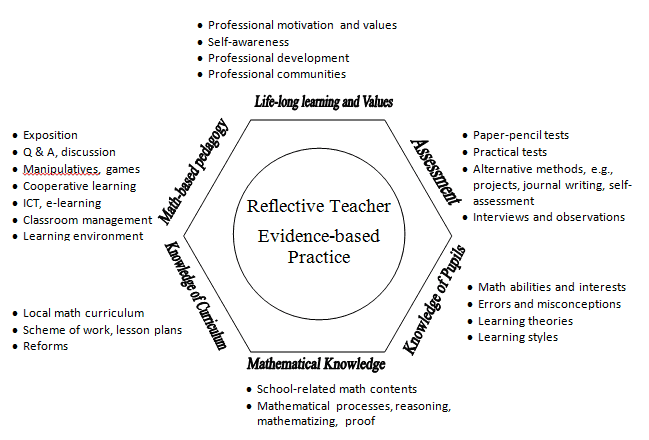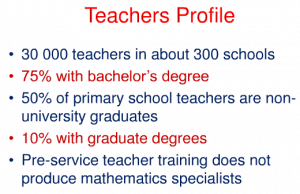In late April, two mathematics conferences were held in San Diego: The NCSM (National Council of Supervisors of Mathematics) and the NCTM (National Council of Teachers of Mathematics). This is the fourth in a series of posts from those conferences.
NCSM Session:
- Integrating Curriculum, Assessment, and Teacher Professional Development: Singapore and the United States by Ban Har Yeap, Khoon Yoong Wong, Jeremy Roschelle and a colleague.
The final Singapore Math-related sessions at NCSM was the result of a joint research project between the National Institute of Education (NIE) in Singapore and the Stanford Research Institute International Center for Technology in Learning in Menlo Park, California (SRI).
Dr. Wong spoke first about the teacher training provided in Singapore. The National Institute of Education is the sole teacher preparation facility in Singapore. This allows for standardized pre-service program. He shared the Pre-service Mathematics Teacher Education Framework that guides teacher training in Singapore:
(click to enlarge)
Teachers in Singapore take one of a couple of routes:
- Diploma in Education (Dip Ed): 2 years, full-time, Primary.
- Bachelor Degree: BA (Ed) or BSc (Ed): 4 years, full-time, Primary or Secondary.
- Postgraduate Diploma in Education (PGDE): 1 year, full-time, Primary or Secondary.
Most interestingly, Dr. Wong added the number of courses out of the total courses that each pre-service track requires:
SK = Subject Knowledge (math for school teaching)
CK = Curriculum Studies (math pedagogy)
- Diploma: SK = 6 /69 CK = 8 /69
- Degree: SK = 4/126 CK = 10/126
- PGDE (primary) SK = 4/44 CK = 8/44
Further reading on teacher preparation: Breaking the Cycle: An international comparison of U.S. mathematics teacher preparation.
Dr. Yeap then spoke about professional development for teachers in Singapore. Many people believe that Singaporean primary teachers are specialists, which they pointed out was simply not factual. From his presentation:
Regardless of where it is initiated, most professional development in Singapore has been workshop-style. One of the big challenges of this type of professional development is that there is no follow-up with the teachers on the material presented. Teachers attend the workshop, then go back to their classroom. (Sound familiar?) Singapore is now working on developing a professional learning culture through more reflective teacher practices. Newer avenues for professional development include Lesson Study, Action Research and Professional Learning Communities.
A major difference between United States and Singapore is the allotment of 100 hours of professional development each year for teachers. This statistic is commonly cited as something that could never be achieved in the United States. In actuality, 100 hours amounts to two and a half weeks of time. Additionally, in Singapore, these 100 hours can be spent on activities that enhance the teacher as a person. Calligraphy, school-based team meetings and pottery-making are among activities that might count for these 100 hours. When questioned, Dr. Yeap also qualified that teachers in Singapore might worry if one teacher was putting in more hours than they were. High expectations among the population dictate that the 100 hours is usually a minimum.
You can view Dr. Yeap’s entire presentation on his website, along with other presentations he has done around the world. Best quote from the session comes from him:
Mathematics is an excellent vehicle for the development and improvement of a person’s intellectual competence.
The researchers from SRI spoke next on the findings from their research project. In the NCSM Conference book, Integrating Curriculum, Assessment, and Teacher Professional Development: Singapore and the United States promised to go beyond the “popular but oversimplified views of Singapore’s successes.” The researchers at SRI repeated that merely adopting Singapore’s textbooks will not be enough to guarantee success here in the United States. It is a wide-spread, but mistaken belief, that a school can simply buy Singapore’s textbooks and duplicate their success in mathematics.
Specifically, they found that it wouldn’t be too challenging to duplicate parts of the Singapore Mathematics Syllabus in the United States, including:
- Creating standards that align to a common assessment.
- A guiding document like Singapore’s pentagon. Dr. Roschelle proposed that the U.S. could use Adding it up: Helping children learn mathematics. At over 450 pages, it doesn’t have quite the allure of the Singaporean document.
- Visual models. Singapore uses a concrete-pictorial-abstract methodology incorporating the model method and the U.S. has the Geometer’s Sketchpad.
Dr. Roshelle listed several items that would be somewhat harder to bring to the United States:
- A high level of professionalism among teachers.
- Systemic rotations through positions (at NIE, Ministry of Education and classrooms).
- Allowing teacher input at all levels of education.
- Systemic leadership.
- A culture of high expectations.
I’m starting with that culture of high expectations. Every school, every student.




















